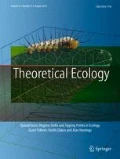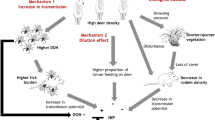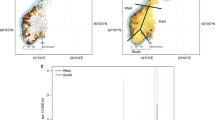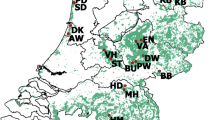Abstract
Borrelia burgdorferi is a vector-bourne zoonosis which propagates in wild populations of rodents and deer. The latter are incompetent for the pathogen but are required for the life cycle of hard-backed ticks which act as a vector for the pathogen. Increasing the diversity of hosts has previously suggested the presence of a ‘dilution effect’ in which such an increase reduces successful pathogen transmission as it increases the chance that a tick will encounter an incompetent host. This paper will produce a model which shows that whilst a dilution effect is possible for a system in which deer are the only incompetent host, this effect is not likely to be strong. Extending the population dynamics to include movement of deer into regions previously only inhabited by competent hosts, we find that, although ticks come in with the deer, there is a significant time lag before Borrelia appears.






Similar content being viewed by others
References
Anderson RM, May RM (1981) The population dynamics of microparasites and their invertebrate hosts. Philos Trans R Soc Lond B Biol Sci 291(1054):451–524
Anderson RM, May RM (1986) The invasion, persistence and spread of infectious diseases within animal and plant communities. Philos Trans R Soc Lond B 314(1167):533–570
Britton NF (2003) Essential mathematical biology. Springer, London
Burgdorfer W, Barbour AG, Hayes SF, Benach JL, Grunwaldt E, Davis JP (1982) Lyme disease—a tick-borne spirochetosis? Science 216(4552):1317–1319
Fisher RA (1937) The wave of advance of advantageous genes. Ann Eugenics 7:355–369
Fuller RJ, Gill RMA (2001) Ecological impacts of increasing numbers of deer in British woodland. Forestry 74(3):193–199. doi:10.1093/forestry/74.3.193
Gern L, Humair PF (2002) Ecology of B. burgdorferi in Europe. In: Lyme borreliosis: biology, epidemiology, and control. CABI Publishing, Wallingford
Gilbert L, Norman R, Laurenson KM, Reid HW, Hudson PJ (2001) Disease persistence and apparent competition in a three-host community: an empirical and analytical study of large-scale, wild populations. J Anim Ecol 70(6):1053–1061. doi:10.1046/j.0021-8790.2001.00558.x
Jaenson TGT, Talleklint L (1992) Incompetence of roe deer as reservoirs of the Lyme borreloisis spirochete. J Med Entomol 29:813–817
Keesing F, Holt RD, Ostfeld RS (2006) Effects of species diversity on disease risk. Ecol Lett 9(4):485–498. doi:10.1111/j.1461-0248.2006.00885.x
Kurtenbach K, Peacey M, Rijpkema SGT, Hoodless AN, Nuttall PA, Randolph SE (1998) Differential transmission of the genospecies of Borrelia burgdorferi sensu lato by game birds and small rodents in England. Appl Environ Microbiol 64(4):1169–1174
Kurtenbach K, Michelis SD, Etti S, Schäfer SM, Sewell HS, Brade V, Kraiczy P (2002) Host association of Borrelia burgdorferi sensu lato—the key role of host complement. Trends Microbiol 10(2):74–79. doi:10.1016/S0966-842X(01)02298-3
Kurtenbach K, Hanincová K, Tsao JI, Margos G, Fish D, Ogden NH (2006) Fundamental processes in the evolutionary ecology of Lyme borreliosis. Nat Rev Microbiol 4:660–669. doi:10.1038/nrmicro1475
Lane RS, Piesman J, Burgdorfer W (1991) Lyme borreliosis: relation of its causative agent to its vectors and hosts in North America and Europe. Annu Rev Entomol 36(1). doi:10.1146/annurev.en.36.010191.003103
LoGiudice K, Ostfeld RS, Schmidt KA, Keesing F (2003) The ecology of infectious disease: Effects of host diversity and community composition on Lyme disease risk. Proc Natl Acad Sci U S A 100(2):567–571. doi:10.1073/pnas.0233733100
Norman R, Bowers RG, Begon M, Hudson PJ (1999) Persistence of tick-borne virus in the presence of multiple host species: tick reservoirs and parasite mediated competition. J Theor Biol 200(1):111–118. doi:10.1006/jtbi.1999.0982
Ostfeld RS, LoGiudice K (2003) Community disassembly, biodiversity loss, and the erosion of an ecosystem service. Ecology 84(6):1421–1427
Palferman T (1994) Lyme arthritis: experience from Somerset, England. In: Axford JS, Rees DHE (eds) Lyme Borreliosis, NATO ASI series. Series A: Life sciences, vol 260. Plenum Press, New York
Prior R (1987) Deer management in small woodlands. Game Conservancy, in association with the British Deer Society, Fordingbridge, Hants
Prior R (1995) The Roe Deer: conservation of a native species. Swan-Hill Press
Pugliese A, Rosà R (2008) Effect of host populations on the intensity of ticks and the prevalence of tick-borne pathogens: how to interpret the results of deer exclosure experiments. Parasitology 135:1531–1544
Randolph SE (1998) Ticks are not insects: consequences of contrasting vector biology for transmission potential. Parasitol Today 14(5):186–192. doi:10.1016/S0169-4758(98)01224-1
Randolph SE (2001) The shifting landscape of tick-borne zoonoses: tick-borne encephalitis and Lyme borreliosis in Europe. Philos Trans R Soc Lond B Biol Sci 356(1411):1045–1056. doi:10.1098/rstb.2001.0893
Schmidt KA, Ostfeld RS (2001) Biodiversity and the dilution effect in disease ecology. Ecology 82(3):609–619
Shigesada N, Kawasaki K (1997) Biological invasions: theory and practice. Oxford series in ecology and evolution. Oxford University Press, Oxford
Spielman A, Wilson ML, Levine JF, Piesman J (1985) Ecology of Ixodes dammini-borne human babesiosis and Lyme disease. Annu Rev Entomol 30(1):439–460. doi:10.1146/annurev.en.30.010185.002255
Telford I Sam R, Mather TN, Moore SI, Wilson ML, Spielman A (1988) Incompetence of deer as reservoirs of the Lyme disease spirochete. Am J Trop Med Hyg 39(1):105–109
Wonham MJ, Lewis MA, Rencławowicz J, Driessche Pvd (2006) Transmission assumptions generate conflicting predictions in host–vector disease models: a case study in West Nile virus. Ecol Lett 9(6):706–725. doi:10.1111/j.1461-0248.2006.00912.x
Acknowledgements
We would like to thank Loukia Lili for her help and advice on the mathematical models. KAJW was supported in part by the Leverhulme Trust; MH was supported by a MTG from the Biotechnology and Biological Sciences Research Council. The work presented here was all completed whilst Klaus Kurtenbach was alive. Sadly he passed away before submission of the paper. We present this work in his memory—his knowledge and passion for understanding all aspects of Lyme disease were the inspiration which motivated this project.
Author information
Authors and Affiliations
Corresponding author
Appendix: Nomenclature
Appendix: Nomenclature
The following gives a list of all parameters used with their description (including units), as well as estimated value.
- r::
-
Density dependent growth rate of deer (day − 1); 1/150 (Prior 1995).
- α j ;:
-
Encounter rate of juvenile ticks with competent hosts (e.g. deer) (day − 1); 0.031 (Pugliese and Rosà 2008).
- α a ;:
-
Encounter rate of adult ticks with incompetent hosts (e.g. rodents) (day − 1); 0.25 (Pugliese and Rosà 2008).
- t j ;:
-
Proportion of ticks which are larvae or nymphs (juveniles); 0.7.
- t a ;:
-
Proportion of ticks which are adults; 0.3.
- a1 = t a α a ;:
-
Overall encounter rate of adult ticks; 0.075
- a2 = t j α j ;:
-
Overall encounter rate of juvenile ticks; 0.0217
- B;:
-
Number of eggs laid per fed adult tick; 500 (Norman et al. 1999).
- K T ;:
-
Carrying capacity of ticks (ha − 1); 50 (equal to B K H 2).
- H1;:
-
Density of competent hosts (ha − 1); 15 (Pugliese and Rosà 2008).
- \(K_{H_2}\);:
-
Carrying capacity of incompetent hosts (ha − 1); 0.1 (Gilbert et al. 2001).
- \(b_{H_1}\);:
-
Birth rate of competent hosts (day − 1); 0.005.
- \(\delta_{H_1}\);:
-
Death rate of competent hosts (day − 1); 0.005 (Pugliese and Rosà 2008).
- δ T ;:
-
Death rate of ticks (day − 1); 0.05775 (Pugliese and Rosà 2008).
- D;:
-
Diffusion rate of deer (dist.2 day − 1); N/A.
- E;:
-
Diffusion rate of ticks per deer (dist.2 day − 1 deer − 1); N/A.
- K;:
-
Ratio of competent hosts with tick carrying capacity; 0.3.
- H;:
-
Ratio of competent hosts with incompetent hosts; 150.
- ε;:
-
Dimensionless diffusion rate of ticks; 0.5–2.5.
Rights and permissions
About this article
Cite this article
Hartfield, M., White, K.A.J. & Kurtenbach, K. The role of deer in facilitating the spatial spread of the pathogen Borrelia burgdorferi . Theor Ecol 4, 27–36 (2011). https://doi.org/10.1007/s12080-010-0072-2
Received:
Accepted:
Published:
Issue Date:
DOI: https://doi.org/10.1007/s12080-010-0072-2




